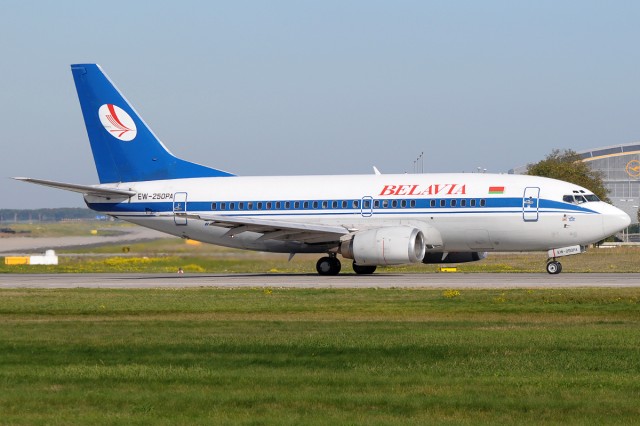
Belavia Boeing 737-500. Image from Wikipedia/CC/Biggerben.
Belavia Belarusian Airlines was founded in March of 1996 and is based at Minsk International Airport in Belarus. The airline is owned by the government and flies to destinations in Asia, Europe and Africa.
The airline currently operates a classic fleet of Boeing 737-300s, 737-500s, CRJ200s and a few Tupolev Tu-154Ms. They have two Embraer 175s and one E-190 on order in hopes to update their fleet.
Even though this is a smaller airline, they have one of the best fleet pages I have seen. You are able to check out external and internal 360 tours and I have to admit that I spent quite a bit of time taking a tour of the Tu-154M.
The livery is one of the few left that remind me of the classic Aeroflot livery. You do not see many liveries that have a cheat-line anymore — they are a dying breed.
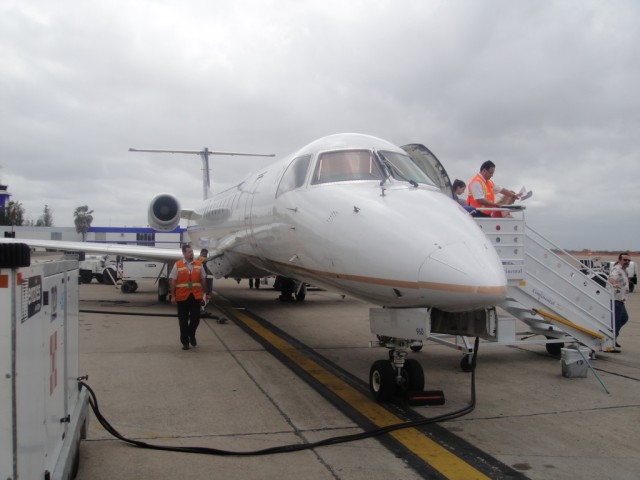
An ERJ is not the most luxurious aircraft to take an international flight on, but it works.
I have wanted to get something off my chest for a while: I used my Passport for the first time ever in 2010. It is a bit embarrassing to admit that, but I hope I can motivate some of you to travel.
When I was a kid, I had a Passport, but never used it. Then, I didn’t get another one until I was almost 30. Now, I had been to every state in the US by the time I was an adult and had visited Canada and Mexico, but never flew internationally. I had a few opportunities, but wasn’t really motivated to take the trip.
My first international flight, was on a Continental ERJ-145 from Houston to Mazatlan, Mexico in May 2010. My second international flight was from San Fransisco to Toronto on a Virgin American Airbus A320 in July 2010. Some might argue that both of those flights are barely international and I somewhat agree. My first flight out of North America was from Los Angeles to Tokyo on a ANA Boeing 777 in October 2010 (on my 30th birthday actually).
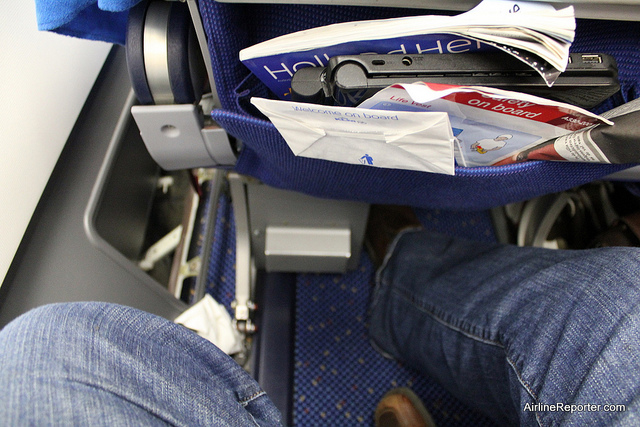
Spending 20 hours in economy on my way home from Rwanda wasn’t the best experience, but TOTALLY worth it.
Since then, I have filled my Passport up quite nicely with trips to Singapore, Rwanda, Frankfurt, Dubai, London, Chile and a second trip to Tokyo.
So why am I admitting all this? To hopefully convince those of you who have dreamed of flying internationally, to take the plunge and do it. I know that most of you reading my blog have probably already taken the plunge, but for those who have not done it in a while or never before, let me tell you that it is worth the effort.
Yes, I am very lucky where many of those trips I did not have to spend much of my own money. But, I still have to pay for some things and had to pay quite a bit for my recent trip to London. That is because once I got the taste of travel, I have changed the way I spend and save my money to allow me to go on future trips. Do I need a fancy car? Nah, I rather drive one that isn’t so fancy and save that money for travel.
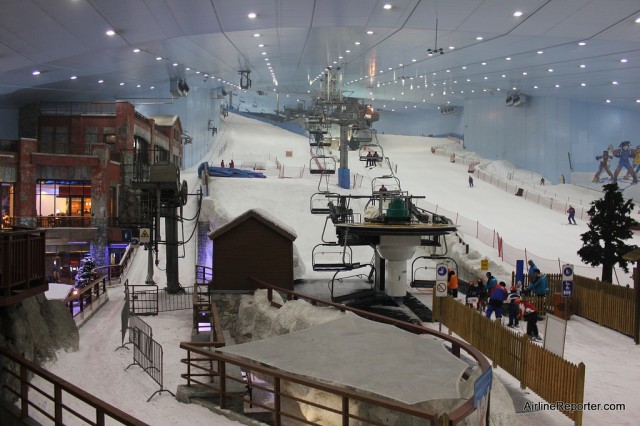
Getting out of the house might means you get to ski in the middle of a desert. Indoor skiing in Dubai.
Before my first international experience (outside of North America) I have to admit that I was a bit scared and did not know what to expect. Especially, when my first real experience was heading to Japan, where I do not know the language. But the world has become global and with a little work, one can normally find someone who knows English or willing to figure things out with pointing to things.
I also really think the smart phone has made traveling so much easier. I am constantly using my iPhone to translate signs, look up where I am going and even to communicate with others. It has made going to a foreign land, so much easier (and less scary) to navigate, even for the novice.
I challenge you — make a plan to take a flight somewhere. If you have not traveled internationally before, no matter your age, do not be afraid to admit it. You will find people will want to help give you advice and motivate you to go on an adventure.
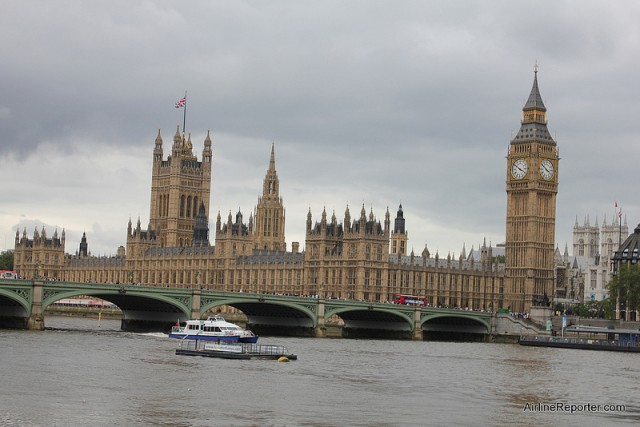
Start out easy. Go to a country that shares your native language. BTW, Big Ben is not THAT big.
I am by no means a travel expert, but there are plenty of people and resources to use out there. I hope to be the cheerleader to push you to explore the world. Unfortunately most of my trips are just a few days and I am not able to get a full taste of the culture, but there is no question that my travel has opened my eyes to new thoughts and ideas that have changed and enriched my life.
So, now that I have admitted that to all of you, I would like to know where are your favorite places to visit around the world and why? I need to start planning a future trip.
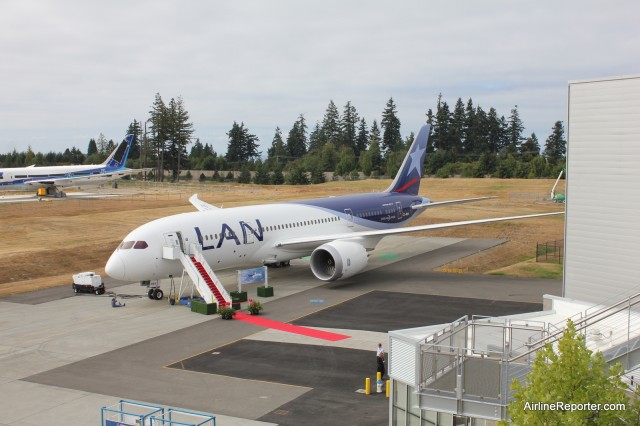
LAN’s first Boeing 787 sits next to the Future of Flight in Everett, WA.
LAN Airlines became the fourth airline in the world and the first in the Americas to take delivery of a Boeing 787 Dreamliner. Lucky for me, I was invited to tag along (Note: LAN flew me down to Santiago, back to Seattle and provided a hotel).
Even though the LAN 787 took off from Everett, WA (where it was built) on Friday, August 31st, the celebration started earlier. There were quite a few journalists from South America who were flown in on Wednesday and the celebration started with a dinner boat cruise. I might have lived in Seattle for 14 years, but the city’s beauty always amazes me.
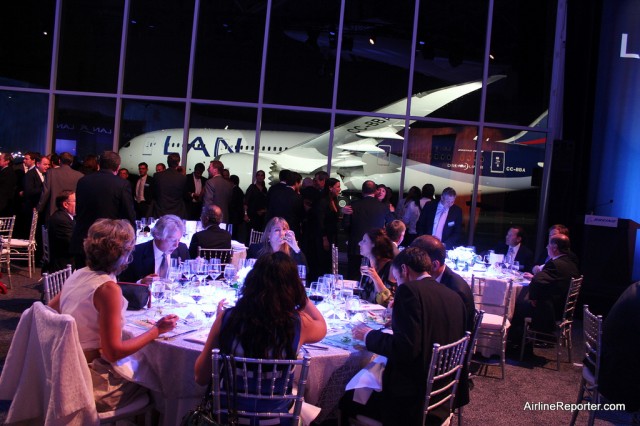
LAN’s 787 sits outside, while Boeing, LAN and media have dinner in the Future of Flight.
All day Thursday, media was invited to take a tour of the Boeing factory and get to know the surrounding area. I was not able to participate in the day events, but they were all things I have done/seen before. Not to say I don’t try to get back into the factory any chance I can.
Thursday night was the official delivery dinner, hosted by Boeing and took place on the gallery floor at the Future of Flight. Boeing always knows how to throw a celebration and this was no different. It was hard to recognize the gallery, especially with their white 747 being painted in LAN’s livery.
A movie was shown highlighting the development of LAN’s first 787. Upon conclusion of the video, the screen was raised, reveling the aircraft outside. Although media had a chance to go outside and take photos beforehand, this was the first time that most of the LAN employees saw their Dreamliner. The excitement is hard to describe.
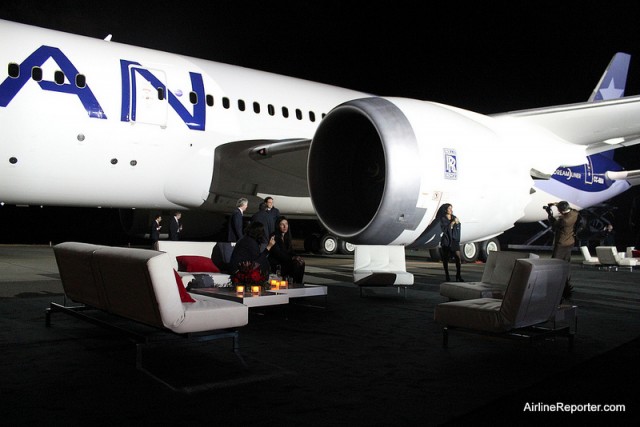
Totally a typical evening hanging out on couches, drinking wine, while under a 787 Dreamliner.
There were a few more speeches, which were almost all in Spanish, so I just clapped when everyone else clapped and smiled when I heard “siete, ocho, siete” (seven eight seven in Spanish).
After dinner, the large glass door opened and we were able to enjoy cocktails outside, next to the aircraft. Couches were set up for people to relax, but many chose to stand while socializing and gazing at the new plane.
I did not end up leaving the Future of Flight until almost 1:30am — like I said, it was a great event. A big bonus was that I didn’t have to be back to Paine Field until 10:00am the next morning.
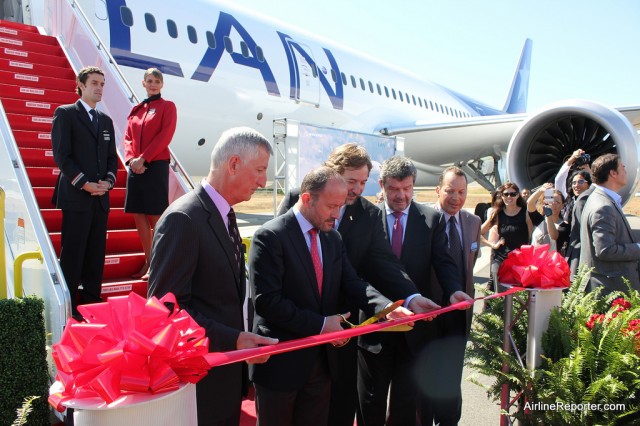
A delivery ceremony wouldn’t be complete without the classic ribbon cutting by executives.
Friday was the big day, but the delivery flight was not scheduled to depart until 5:00pm. Upon arrival, we had the opportunity to get on the plane and see the interior for the first time. Even though LAN’s new seating product had premiered on the 767 a few months prior, it was done more or less in secret and fully announced with the 787.
I felt very privileged to board my seventh Dreamliner for an interior tour (others: Boeing ZA003, ANA JA801A, ANA JA802A, JAL JA825J, Qatar’s 787, United N20904). I was excited to compare. I have to say that it never gets old boarding a new Dreamliner and taking in that new-plane smell.
LAN’s entry way on the 787 wasn’t as dynamic as Qatar’s and a bit more like United’s. Sort of a mid-ground for providing a warm welcome, but not giving up too much space. LAN laid out the Business cabin in a 2-2-2 set up and the economy seats in a 3-3-3 configuration. I knew I was going to be spending about 12.5 hours in economy, so I made sure to check out the front of the plane as much as possible.

Business Class on LAN’s brand new Boeing 787 Dreamliner. More comfy than economy.
When I posted a photo on my Facebook of the new Business Class seats, many folks were not fans. Just like people, sometimes seats do not photo well. I think the one above captures the look of the new product much better than iPhone and Tweeted photos. I am happy to say that the product looks better in person than it does in even the higher quality photos.
Although the seats are interesting, I always enjoy checking out the areas that most passengers will never see: the pilot’s rest area above the cabin in the front, the flight deck and the crew rest area, which are upgraded economy seats.
Airline customers have the choice to offer a rear sleeping area for crew (like on United’s 787). LAN opted for economy seats, that can recline, in a 2-3-2 layout by the window, that are curtained off and have a separate lighting zone than the rest of the cabin.
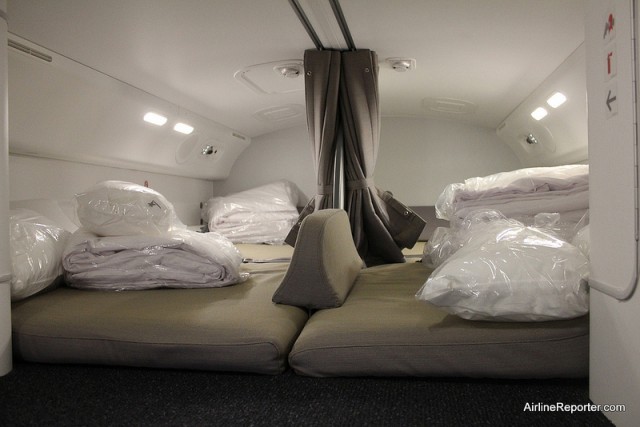
The pilot-crew rest area located above the main cabin, in the front.
After our interior tour we had about three hours to burn before departing Paine Field. My game plan was to work on the blog, while waiting for our flight to leave, but ran into a problem when trying to find my bag. I was one of the first to arrive at the Future of Flight (shocking, I know) and when I did, no one had put their carry-on bags down. The place where I put my bag (right by the security scanner) turned out to be the location for checked bags… oops. In my defense, there were not signs posted at the time.
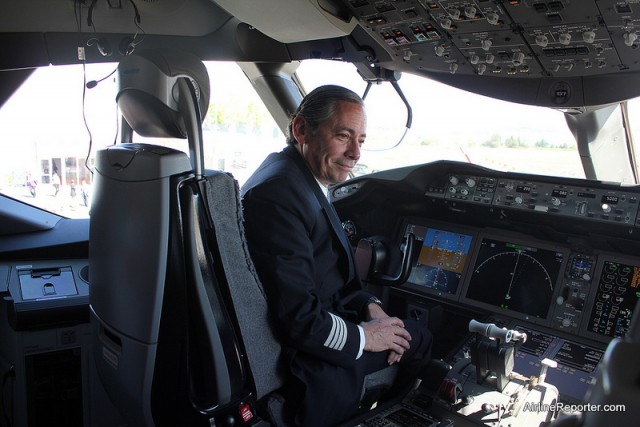
The best seat in the house.
After searching through all the carry-ons multiple times and not finding mine, I figured it was picked up. The problem was all the checked bags were already scanned, loaded into crates and secured. I talked to three different people and two said there was no way could I get access to my bag and one said, “maybe.”
Luckily, I had my Passport on me, but my bag had my laptop and all my chargers for my phone and camera. I was nice and polite, but made it quite clear how happy I would be to have my bag.
About an hour later, a lovely woman came up to me saying that I could go with her to get my bag — I wanted to give her a hug. As an extra bonus, the bag search was down on the east-side of the airport and we were on the west side. I got to take a van ride around Paine Field and right down the flight line. Unfortunately I was not able to take photos, but I have the memories.
I am thankful I was able to carry my bag on, especially since my camera battery went out a few hours into the flight. Needless to say, that would have made PART 2 of this story very difficult.
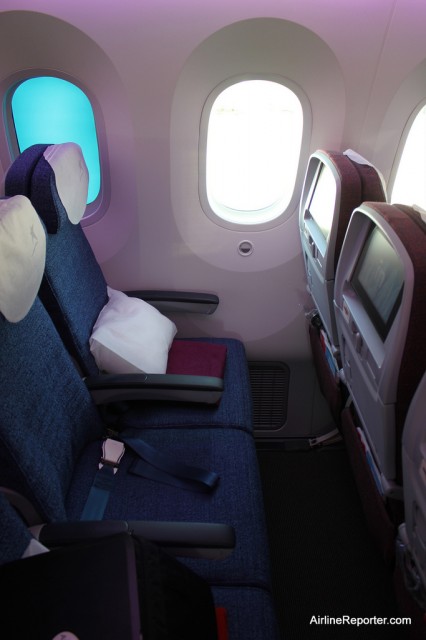
My seat was 15A, but I had the whole row for sleeping.
Shortly after fetching my bag, it was time to board. We each had hand written tickets (my name was wrong, but whatever) and went through Boeing security (kind of like TSA, but nicer). Then it was time to board, get settled in seat 15A and prepare for a 12.5 hour flight to Santiago. Being able to have the experience to fly non-stop from Everett to Santiago on a Boeing 787 Dreamliner was truly a dream come true.
Continue to PART 2…
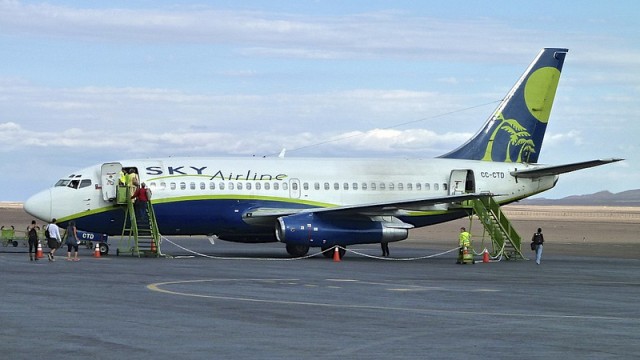
A classic Boeing 737-200 seen in Sky Airlines livery. Photo by alobos flickr.
You don’t see too many Boeing 737-200s flying around the world much anymore and especially one with such a cool looking livery. When I recently landed at Comodoro Arturo Merino Benàtez International Airport (SCL) in Santiago, Chile, this livery caught my eye.
Sky Airline (notice the lack of an “s”) is based at SCL and was founded in 2001. It is Chile’s second largest airline and is considered a low-cost carrier. The airline mostly operates domestically, but has international routes to Argentina, Bolivia, Brazil and Peru.
The airline operates a fleet of Airbus A319s, A320s and is in the processes of phasing out the classic Boeing 737-200.
I seem to be a sucker for a blue/green livery and with the swooping line and palm trees on the tail, it looks slick. Although I am sure the passenger experience will improve with the elimination of the 737-200 from the fleet, it is a bit sad from the AvGeek perspective.














